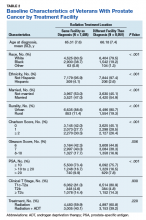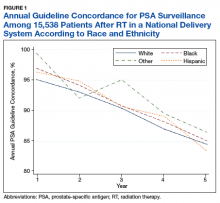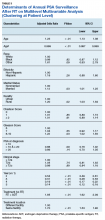Primary Outcome
The primary outcome was receipt of guideline concordant annual PSA surveillance in the initial 5 years following RT. We used laboratory files within the VA Corporate Data Warehouse to identify the date and value for each PSA test after RT for the entire cohort. Specifically, we defined the surveillance period as 60 days after initiation of RT through December 31, 2012. We defined guideline concordance as receiving at least 1 PSA test for each 12-month period after RT.
Statistical Analysis
We used descriptive statistics to characterize our cohort of veterans with prostate cancer treated with RT with or without concurrent ADT. To handle missing data, we performed multiple imputation, generating 10 imputations using all baseline clinical and demographic variables, year of diagnosis, and the regional VA network (ie, the Veterans Integrated Services Network [VISN]) for each patient.
Next, we calculated the annual guideline concordance rate for each year of follow-up for each patient, for the overall cohort, as well as by age, race/ethnicity, and concurrent ADT use. We examined bivariable relationships between guideline concordance and baseline demographic, clinical, and delivery system factors, including year of diagnosis and whether patients were treated at the diagnosing facility, using multilevel logistic regression modeling to account for clustering at the patient level.
Analyses were performed using Stata Version 15 (College Station, TX). We considered a 2-sided P value of < .05 as statistically significant. This study was approved by the VA Ann Arbor Health Care System Institution Review Board.
Results
We evaluated annual PSA surveillance for 15,538 men treated with RT with or without concurrent ADT (Table 1).
Most men were white (70%), with 29% black and 3% Hispanic. Half (51%) the men were married, and the minority lived in rural areas (16%). The majority of men had screen-detected prostate cancer that was Gleason score ≥ 7, and with PSA ≤ 10 ng/mL. Most men were treated without concurrent ADT (60%), while those with concurrent ADT tended to have more aggressive disease factors (ie, higher PSA and Gleason score). Approximately half (52%) of veterans with prostate cancer received RT away from their diagnosing facility.On unadjusted analysis, annual guideline concordance was less common among patients who were at the extremes of age, white, had Gleason 6 disease, PSA ≤ 10 ng/mL, did not receive concurrent ADT, and were treated away from their diagnosing facility (P < .05) (data not shown). We did find slight differences in patient characteristics based on whether patients were treated at their diagnosing facility (Table 2).
Patients treated at facilities other than where they were diagnosed were more rural, white, and married, with slight differences in baseline PSA and Gleason scores but similar use of radiation monotherapy and concurrent ADT.Overall, we found annual guideline concordance was initially very high, though declined slightly over the study period. For example, guideline concordance dropped from 96% in year 1 to 85% in year 5, with an average patient-level guideline concordance of 91% during the study period. We found minimal differences in annual surveillance after RT by race/ethnicity (Figure 1).
On multilevel multivariable analysis to adjust for clustering at the patient level, we found that race and PSA level were no longer significant predictors of annual surveillance (Table 3).
However, the following factors remained significant determinants of lower guideline concordance: extremes of age, Gleason 6 disease, RT without concurrent ADT (adjusted odds ratio [aOR] 1.00 radiation therapy alone vs 1.84 radiation therapy with ADT, P < .01; 95% CI, 1.62-2.09), and treatment at a different facility from where one was diagnosed (aOR 1.00 different facility vs 1.70 same facility, P < .01; 95% CI, 1.53-1.90). The following factors became significant on multivariable analysis: being nonmarried (aOR 1.00 nonmarried vs 1.12 married, P = .03; 95% CI, 1.01-1.25), and urban residence (aOR 1.00 urban vs 1.20 rural, P = .02; 95% CI, 1.03-1.39). Men treated with RT with concurrent ADT were more likely to have greater annual surveillance whether they were treated within or outside of their diagnosing facility (Figure 2).
















